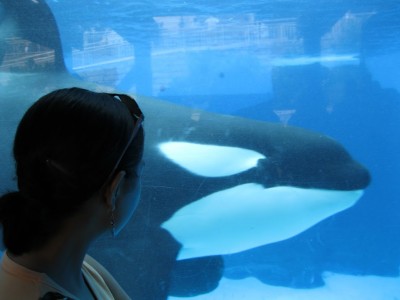This may be a surprising departure from my usual blog topics as you will find nothing about cats or dogs in today’s post. This is to share my personal reactions and the insights I gained from watching Blackfish a documentary about captive killer whales.
In October of 2010, I visited SeaWorld amusement park in San Diego and watched “Believe” the killer whale show which is the main attraction of the park. Only a few days ago, I watched Blackfish, an eye-opening documentary about captive killer whales (orcas) and the tragic death of SeaWorld trainer Dawn Brancheau who was attacked by Tilikum a bull killer whale that she had been working with.
It surprised me to discover that this incident had happened earlier in the very same year that I had visited SeaWorld, and I realized only then that the show that I had watched had been edited as a result of Brancheau’s death: For their own safety, the trainers were no longer allowed to do close proximity water work with the whales. More important than this realization, however, is the fact that I now feel ashamed that I ever patronized this and other shows of captive marine mammals performing for human entertainment.
I’d heard about animal activist groups protesting captive marine mammals in amusement parks before, and I even agreed with their efforts. But when you get to visit Hong Kong’s Ocean Park with your family or when your relatives in the US offer to pay your park ticket at SeaWorld, you momentarily (and shamefully) are willing to suspend your convictions. That’s how it was for me, i hate to admit: Uninformed about all the facts and details, I could bring myself to make light of the issue because of my ignorance. Despite the fact that a tiny little voice in my head was speaking against going there, on that trip to SeaWorld, I was absolutely excited by the opportunity to see a real live killer whale.
It’s easy to overcome the guilt when you’re there sitting on the bleachers surrounding the performance pool watching the whales and trainers go through their routines. You think, “Hey, these whales look happy! They work so wonderfully well with their human trainers. I’m sure the humans are doing everything right by them.” When dogs perform that well with humans, you know there’s a strong relationship between animal and handler, right? And so you believe that these animals are cared for properly, and that this is a good thing, for people to see these whales up close, for ordinary folks to be educated about marine mammals and to learn to appreciate them.
Thinking about it now, I ask myself, really, what did I learn at SeaWorld about killer whales? Did I appreciate them more after the show? In truth, everything I know and everything I appreciate about orcas I got from watching documentaries on Animal Planet or National Geographic. All I got out of the park show was a thrill and a few pictures, and these at the expense of a highly intelligent, sentient animal who endures an emotionally stressed, understimulated and lonely life in a glorified fish tank.
I wrote this article to express my guilt, and also so that I can in a small way make a difference by raising awareness for the living conditions of captive killer whales. I cannot myself argue eloquently enough all the points against keeping marine mammals – specifically orcas – in captivity. Thus, at the end of this article, I leave you with the words of men and women more knowledgeable on the topic, and hope you will go through some resources on the issue to help you educate yourself and make up your own mind.
In closing, my personal stand on the issue is this: Not being an expert on the topic, I hesitate to say for certain that releasing these animals into the wild is the best solution for them. At the very least, the value to science and education, and the humaneness of the capture and keeping of marine mammals (and for that matter, other wild animals) needs to be seriously reconsidered. For myself, what I am certain of is that I will no longer knowingly patronize amusement parks that feature marine mammals in shows. While other aspects of SeaWorld and similar parks may indeed be contributing positively to wildlife conservation, it is the demand for such entertainment that drives corporate interests to continue animal exploitation. This to me throws a dark shadow over all other good intentions. From what we have learned about the intelligence and the rich emotional and social lives of killer whales over the years, it seems only inhumane to turn a blind eye to that knowledge and continue to use them in such a manner for profit, especially considering that what the whales get in return is lifelong confinement.
As Jane Goodall once said in her TedX lecture in 2007 “Once we’re prepared to admit that after all, we’re not the only beings with personalities, minds and above all feelings, and then we start to think about ways we use and abuse so many other sentient, sapient creatures on this planet, it really gives cause for deep shame…”
We demand proper treatment and respect because we are humans and individuals, but we should accept that for what we demand for ourselves equal consideration must be granted to other species with which we share this planet.
To learn more about the issues surrounding orcas in captivity, I hope you take time to view the following media or resources.
Blackfish Trailer
A very powerful and moving documentary. I was in tears 10 minutes into the film, and deeply, deeply ashamed of the cruelty of which the human species is capable.
SeaWorld responds to questions about captive orcas, ‘Blackfish’ film
SeaWorld Vice President of Communications Fred Jacobs answers some questions about the controversy over the film and about keeping orcas in captivity. A comment by Naomi Rose in the comments section is also noteworthy.
The Killer in the Pool by Tim Zimmermann
According to the Blackfish Movie Facebook Page, this is the original article that inspired Blackfish director Gabriela Cowperthwaite to make the film. Excerpt: “He glanced through the glass and saw Tilikum staring back, with what appeared to be two human feet hanging down his side. There was a nude body draped across Tilikum’s back.”
A Day in the Life of Lolita, the Performing Orca
Orca biologist Ingrid Visser pays a visit to a killer whale named Lolita kept at Miami Seaquarium. Produced by Daniel Azarian. YouTube description excerpt: “Lolita, first named Tokitae, was violently torn away from her family and her natural world in 1970. Since then she has dutifully performed the same boring circus routines twice daily in the hot Miami sun.”
Jean-Michel Cousteau’s Statement on Captive Orcas and the Trainer Killed at SeaWorld
Jean-Michel Cousteau states here (and I agree) that “Maybe we as a species have outgrown the need to keep such wild, enormous, complex, intelligent, and free-ranging animals in captivity, where their behavior is not only unnatural; it can become pathological…Maybe we have learned all we can from keeping them captive.”

